Flaming Mountains
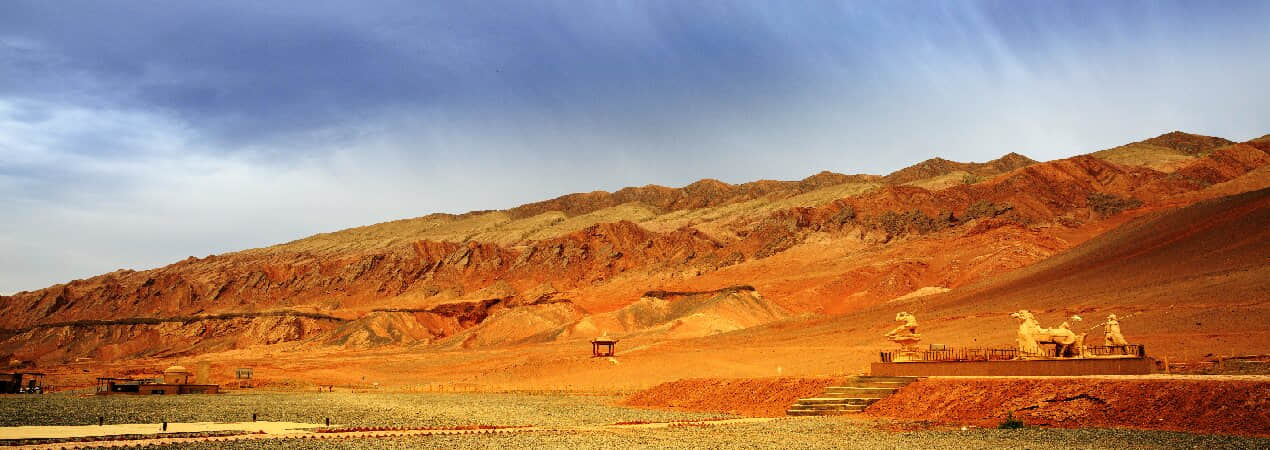
The Flaming Mountains Scenic Area is located on the eastern side of Turpan City, about 30 kilometers by car from the urban area. It is a scenic area characterized by fiery red reddish-brown sandstone landforms. Historically, it was the location of the ancient Gaochang Kingdom, and in legend, it is the Flaming Mountains where Tang Sanzang and his disciples borrowed the Plantain Fan to extinguish the great fire in ''Journey to the West''. It is a popular destination for many tourists visiting Turpan.
- Chinese name: 火焰山景区 Huǒ Yàn Shān Jǐng Qū
- Suggested time: 2 - 3 hours
- Ticket: The adult ticket price is 40 yuan per person. For children with a height of 1.2 - 1.5 meters, the ticket price is 20 yuan.
- Open hours: In the peak season (from April 21st to October 20th), it is open from 8:00 to 21:00. In the off-season (from October 21st to April 20th of the next year), it is open from 10:00 to 18:30.
- The best time to visit: Spring (April - May) and autumn (September - October) are the best times to visit, with pleasant climate. However, if you want to experience the extreme heat, summer (June - August) is also an option.
- Address: North of 312 National Road, Gaochang District, Turpan City, Xinjiang Uygur Autonomous Region, China
- How to get there: You can take a bus from Turpan Bus Station. There are multiple departures daily, with a ticket price of 15 yuan per person (every 30 minutes).
Highlights of Flaming Mountains
Flaming Mountains
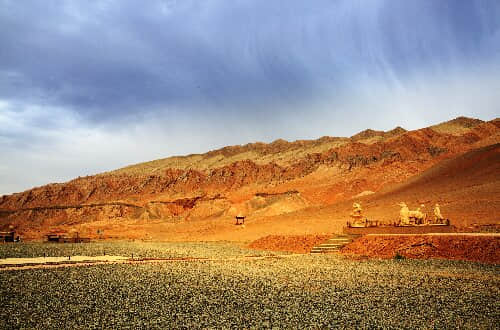 Flaming Mountains
Flaming MountainsStepping into the Flaming Mountains, you can visit the legendary place where Sun Wukong borrowed the banana fan three times in Journey to the West. There are many elements of the novel “Journey to the West” here. You can also see the most typical reddish-brown sandstone landforms on Earth, appreciate the magnificent geological wonders and unique cultural history, and admire the grandeur of the mountains. The Flaming Mountains are the hottest place in China. The temperature can reach 47.8℃ in summer, and the highest surface temperature on the sunny side of the Flaming Mountains can reach 82.3℃. Eggs can be roasted in the sand pit. The bigger the sun and the hotter the weather, the redder and brighter the color of the Flaming Mountains. Therefore, midsummer is the most beautiful season of the mountains.
If you can't stand the high temperature, you can choose to visit in spring and autumn (April to May, September to October). At this time, the temperature is pleasant (20-30℃), suitable for both escaping the heat and scenery viewing. However, although summer (June to August) is extremely hot (the surface temperature exceeds 70℃), you can experience the ultimate "Fire Continent" wonders. It is recommended to visit in the early morning or evening.
Tips: You must bring high-protection sunscreen, wide-brimmed hats, and sunglasses when visiting the Flaming Mountains Scenic Area, as the ultraviolet intensity here is extremely high. Additionally, carry a water bottle to replenish water. When sightseeing, avoid outdoor activities during peak midday heat to prevent heatstroke. Respect local customs and seek consent before photographing Uyghur residents.
Underground Palace
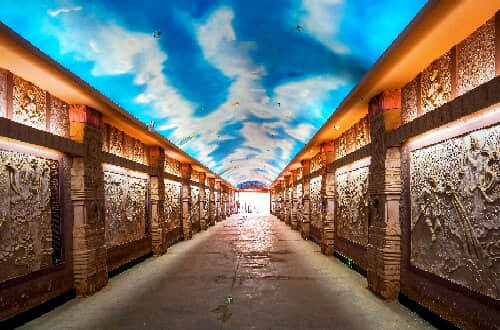 "Journey to the West" Cultural Corridor
"Journey to the West" Cultural CorridorThe underground palace has a construction area of 9,000 square meters, including the Journey to the West Cultural Corridor, Flaming Mountains Geography and Culture Hall, Gaochang Historical Celebrities Hall, Giant Thermometer Exhibition Hall, and Leisure Shopping Center.
Among them, the "Journey to the West" Cultural Corridor is 50 meters long, 6 meters wide, and 15 meters underground. In the corridor, you can see the reliefs of Journey to the West, which are lifelike and vividly reproduce the hardships of Tang Sanzang and his disciples on their "journey to the West". Here, you can immerse yourself in the stories of "Journey to the West".
Giant Thermometer
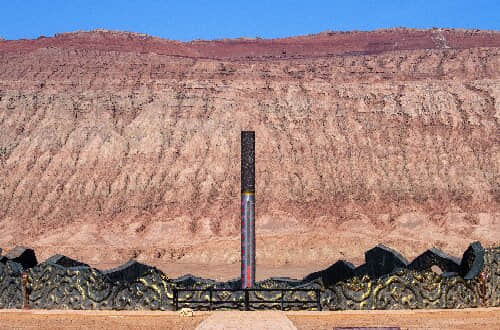 Giant Thermometer
Giant ThermometerAt the entrance of the scenic area stands a 12-meter-tall giant thermometer shaped like the "Golden Cudgel", which displays real-time surface temperature. It is a popular highlight of the area and a must-visit attraction for tourists to the Flaming Mountains. The thermometer's design is inspired by Sun Wukong's "Golden Cudgel": both ends are iron parts carved with patterns, the middle section is the thermometer itself, and beside the cudgel-shaped structure, there is a Guinness World Records certificate stating that it is the largest thermometer in the world.
"Journey to the West" Sculpture Group
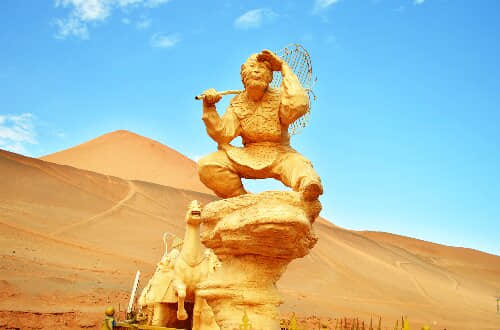 "Journey to the West" Sculpture Group
"Journey to the West" Sculpture GroupUpon entering the Flaming Mountains, you are greeted by reddish rocky mountains. In the scenic area's square, there are numerous sculptures from "Journey to the West", including classic characters such as Sun Wukong, Princess Iron Fan, and the Ox Demon King. One sculpture depicts Sun Wukong soaring through the clouds with his "Golden Cudgel", standing on a stone inscribed with "Flaming Mountains." Beside it is a bronze sculpture showing Tang Sanzang and his four disciples in their plight when blocked by the Flaming Mountains. Not far away, the Ox Demon King is portrayed in armor riding his mount, while Princess Iron Fan carries a plantain fan on her back. The sculpture group reproduces the mythical scene of "Borrowing the Plantain Fan Three Times" from "Journey to the West", where you can take photos with the sculptures.
Educational Value
The Flaming Mountains are a typical graben-type structural mountain range, whose formation is the result of plate movement and crustal faulting. In science education, they can serve as intuitive teaching aids to help students understand geological concepts such as plate tectonics, faults, and folds. The exposed sandstone and conglomerate layers from the Jurassic, Cretaceous, and Tertiary periods in the mountain clearly demonstrate the stratigraphic structures of different geological eras. This allows people to understand the long process of stratum deposition, rock formation, and evolution, and recognize the complexity and continuity of Earth's history.
Activities to do at Flaming Mountainsv
Geological Exploration: You can organize professional geologists or guides to lead field trips to investigate the stratigraphic structure of the Flaming Mountains. Observation points will be set up in specific areas, providing tools such as magnifying glasses and geological hammers for hands-on rock exploration. This allows participants to feel geological changes firsthand and intuitively understand knowledge related to geological structures.
Karez Simulation Construction: A small-scale Karez model construction area will be created, where visitors can simulate the excavation and construction process of Karez using simple materials under the guidance of professionals. This activity helps them understand the structure and working principles of this unique water conservancy project.
Ethnic Craft Experience: Engage in ethnic handicraft-making activities, such as learning to make Uyghur embroidered hats and embroidery, to deeply experience the rich local ethnic culture.
Drop us a line and we'll connect you with the top China expert in no time!